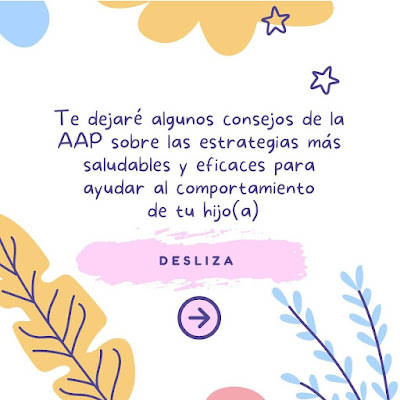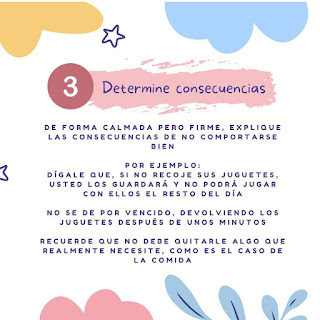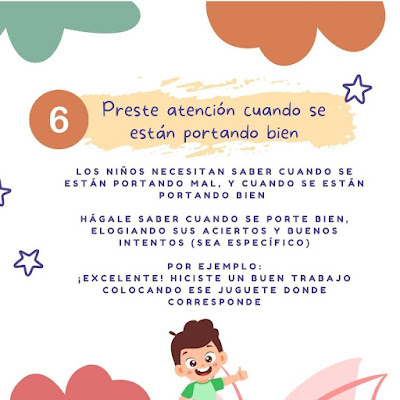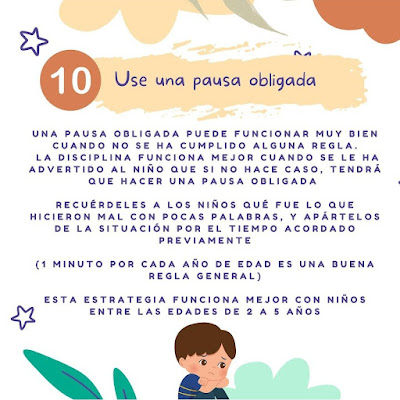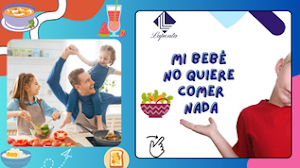PRÁCTICAS EFICACES PARA GENERAR DISCIPLINA EN LOS NIÑOS
EFFECTIVE PRACTICES TO GENERATE DISCIPLINE IN CHILDREN
EDITORIAL ESPAÑOL
==================
La disciplina es una parte importante en la educación de los niños, ya
que les ayuda a aprender a comportarse apropiadamente y a desarrollar o
mejorar sus habilidades tanto personales como sociales. Te dejaré
algunos consejos de la AAP (Asociación Americana de Pediatría),
sobre las estrategias más saludables y eficaces para ayudar al
comportamiento de tus niños:
1.) Mostrar y decir: Enseñe a los niños la diferencia
entre lo bueno y lo malo con palabras calmadas, si lo hace con
violencia o molesta provocará el rechazo del niño, o simplemente NO
entenderá lo que quiere decirle.
2.) Ponga límites: Aplique
reglas claras y coherentes que sus hijos puedan seguir, y
cerciórese de que sus palabras sean adecuadas para su edad, usar
un lenguaje muy elaborado hará que el niño no entienda y por lo
tanto no habrá aprendizaje.
3.) Determine consecuencias: De forma calmada
pero firme, explique las consecuencias de no comportarse
bien. Por ejemplo:
Dígale que, si no recoge los juguetes usted los guardara y no
podrá jugar con ellos por el resto del día. No se dé por
vencido, devuélvale los juguetes después de unos minutos, esto
generará en el niño una conducta positiva porque entenderá el
verdadero comportamiento.
4.) Escuche bien lo que dice: Escuchar es
importante, escuche bien lo que dice. Deje que su niño
termine su argumento antes de ayudarlo a resolver el
problema si existe como tal, de lo contrario aplaudir y
animar si el comportamiento fue el adecuado, siempre con
palabras fáciles de entender por el niño de acuerdo a su
edad.
5.) Preste atención: La forma más efectiva de disciplinar a los niños es
ponerles atención, para fomentar los buenos
comportamientos y desalentar los malos. En otras palabras,
no estar pendiente del comportamiento del niño es
como ver un barco a la deriva, pues no habrá un capitán
que en este caso es usted, quien ayudara o enseñara cual
es la ruta o vía correcta.
6.) Preste atención cuando se esté portando bien: Los niños necesitan saber cuando se están portando
mal, y cuando se están portando bien. Hágale saber cuando se porte bien, elogiando sus
aciertos y buenos intentos (sea
específico). Por ejemplo:
¡Excelente! Hiciste un buen trabajo colocando ese
juguete donde corresponde.!
El niño al observar la conducta del padre
se sentirá atendido y aprenderá las
buenas actitudes. Esta estrategia funciona muy
bien !
7.) Tratar de estar listo siempre para
cualquier problema: Prepárese con anticipación para las actividades
venideras, y dígales cómo quiere que se
comporten. Siempre existirán eventualidades buenas
o malas, y hay que estar preparados para dar las
respuestas adecuadas ante ellas, y no dejarlas
pasar.
8.) Reoriente el mal
comportamiento:
Algunas veces los niños se comportan mal
porque están aburridos y no saben qué otra
cosa hacer. Busque mantener su mente ocupada
(sanamente).
Lamentablemente mucho padres hoy día por la
"moda", utilizan las pantallas, de
teléfonos móviles o tabletas, para
entretener al niño, lo cual en cierto modo no
esta mal, pero si abusan de ello,
estarán generando un probable y futuro
déficit de atención.
9.) Sepa cuándo NO es bueno reaccionar:
Mientras que su hijo(a) no esté haciendo
algo peligroso y reciba mucha atención por su
buen comportamiento, ignorar el mal
comportamiento puede ser una forma muy eficaz de
frenar el mismo, Ignorar el mal comportamiento
también le puede enseñar a que las acciones
tienen consecuencias.
Por ejemplo:
Si su hijo(a) tira las galletas al piso
adrede, se dará cuenta que no habrá más
galletas para comer. Muy pronto aprenderá a no
tirar las galletas al piso.
10.) Hacer una pausa obligada: Una pausa obligada puede funcionar muy
bien cuando no se ha cumplido alguna
regla. La disciplina funciona mejor cuando se le
ha advertido al niño que si no hace caso,
tendrá que hacer una pausa obligada.
recuérdeles a los niños qué fue lo que
hicieron mal con pocas palabras, y
apártelos de la situación, por el tiempo
acordado previamente.
(1 minuto por cada año de edad es una buena
regla general), esta estrategia funciona
mejor con niños entre las edades de 2 a 5
años.
Resumiendo: Es importante
recordar que cada padre tiene su
propio estilo para enseñar y educar
pero la disciplina debe ser
SIEMPRE consistente y
cariñosa, y EFECTIVA, evitando
métodos VIOLENTOS, abusivos,
que lo único que
lograrán es provocar rechazo y
un fracaso total a la hora de
impartir disciplina.
EDITORIAL
ENGLISH
==================
Discipline is an
important part of
children's education, as
it helps them learn to
behave appropriately and
develop or improve their
personal and social
skills. I will leave you
some advice from the AAP
(American Association of
Pediatrics), on the
healthiest and most
effective strategies to
help your children's
behavior:
1.) Show and
tell:
Teach children the
difference between
good and bad with calm
words, if you do it
with violence or
annoyance it will
cause the child to
reject them, or they
will simply NOT
understand what you
want to say.
2.) Set
limits: Apply clear and
consistent rules
that your children
can follow, and
make sure your
words are
appropriate for
their age, using
very elaborate
language will
cause the child
not to understand
and therefore
there will be no
learning.
3.) Determine
consequences: Calmly but firmly,
explain the
consequences of not
behaving well. For
example:
Tell him that if
he doesn't pick up
the toys you will
put them away and
he won't be able
to play with them
for the rest of
the day. Do not
give up, return
the toys after a
few minutes, this
will generate
positive behavior
in the child
because she will
understand the
true behavior.
4.) Listen
well to what
he
says: Listening is
important,
listen well to
what he says.
Let your child
finish his
argument before
helping him
solve the
problem if it
exists as such,
otherwise
applaud and
encourage if the
behavior was
appropriate,
always with
words easy for
the child to
understand
according to his
age.
5.) Pay
Attention: The most
effective way to
discipline
children is to
pay attention to
them, to
encourage good
behaviors and
discourage bad
ones. In other
words, not being
aware of the
child's behavior
is like seeing a
ship adrift,
since there will
be no captain,
which in this
case is you, who
will help or
teach you what
the correct
route or path
is.
6.) Pay
attention
when they
are behaving
well: Children need
to know when
they are
behaving badly,
and when they
are being good.
Let him know
when he behaves
well, praising
his successes
and good
attempts (be
specific). For
example:
Excellent! You
did a good job
putting that
toy where it
belongs!
By observing
the father's
behavior, the
child will
feel cared for
and will learn
good
attitudes.
This strategy
works very
well!
7.) Always
try to be
ready for
any
problem: Prepare in
advance for
upcoming
activities,
and tell them
how you want
them to
behave. There
will always be
good or bad
eventualities,
and we must be
prepared to
give the
appropriate
responses to
them, and not
let them pass.
8.) Redirect
bad
behavior: Sometimes
children act out
because they are
bored and don't
know what else
to do. Seek to
keep your mind
busy
(healthily).
Unfortunately,
many parents
today, due to
"fashion", use
screens,
mobile phones
or tablets, to
entertain
their
children,
which in a way
is not bad,
but if they
abuse it, they
will be
generating a
probable
future
attention
deficit. .
9.) Know
when it is
NOT good
to
react: As long as
your child
is not doing
something
dangerous
and receives
a lot of
attention
for his or
her good
behavior,
ignoring bad
behavior can
be a very
effective
way to stop
it. Ignoring
bad behavior
It can also
teach him
that actions
have
consequences.
For
example:
If your child
throws the
cookies on the
floor on
purpose, she
will realize
that there
will be no
more cookies
to eat. Very
soon she will
learn not to
throw the
cookies on the
floor.
10.) Take
a forced
break: A forced
pause can
work very
well when a
rule has not
been
followed.
Discipline
works best
when the
child has
been warned
that if he
does not
listen, he
will have to
take a
mandatory
break.
Remind the
children
what they
did wrong in
a few words,
and remove
them from
the
situation
for the
previously
agreed upon
time.
(1 minute per
year of age is
a good general
rule), this
strategy works
best with
children
between the
ages of 2 and
5.
In summary: It
is important
to remember
that each
parent has
their own
style for
teaching and
educating, but
discipline
must ALWAYS be
consistent,
loving, and
EFFECTIVE,
avoiding
VIOLENT,
abusive
methods, which
will only
cause
rejection and
total failure
at the time to
impart
discipline.



